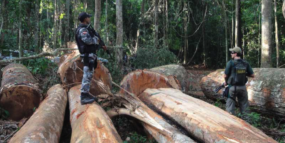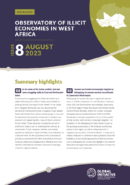Posted on 18 Feb 2012
Every two seconds, across the world, an area of forest the size of a football field is clear-cut by illegal loggers.1 In some countries, up to 90 percent of all the logging taking place is illegal.2 Estimates suggest that this criminal activity generates approximately US$10–15 billion annually worldwide—funds that are unregulated, untaxed, and often remain in the hands of organized criminal gangs. Thus far, domestic and international efforts to curb forest crimes have focused on preventative actions, but they have had little or no significant impact.
While prevention is an essential part of enforcement efforts to tackle illegal logging, it has not halted the rapid disappearance of the world’s old-growth trees. New ideas and strategies are needed to preserve what is left of forests. This paper suggests that current practice be combined with a more targeted, punitive approach, through more effective use of the criminal justice system. It argues that the criminal justice system should form an integral part of any balanced and organized strategy for fighting forest crime. This strategy should include initiatives to enhance the efficiency of criminal justice in combating illegal logging—that is, the investigation, prosecution, and conviction of cases, as well as the confiscation of the proceeds of criminal activity. These initiatives should be deployed in parallel with preventive programs, and the two approaches should complement and reinforce each other.
The criminal justice system has been used in the fight against illegal logging, but only in very sporadic instances and in limited and ineffective ways. Moreover, in those few cases, it has tended to target low-level criminals whose involvement in illegal logging is due to poverty. As such, it has created no real deterrent and has encouraged skeptics to further discount the relevance of criminal justice methods. Large-scale illegal operations are carried out by sophisticated criminal networks, and law enforcement actions need to be focused on the “masterminds” behind these networks—and the highlevel corrupt officials who enable and protect them. Pursuing these important targets through the criminal justice system will require creativity and a clear focus on those criminal justice rules and procedures that prove most effective.
The objective of this paper is to inform policy makers and forestry and law enforcement actors how they can use the criminal justice system in fighting illegal logging. It seeks to mobilize them to take action and address the various criminal acts involved in illegal logging operations. The paper puts forward practical suggestions that can be implemented to achieve a tangible improvement in this fight. Rather than focusing on a single element of the criminal justice system, it provides a broad overview of the topic.


